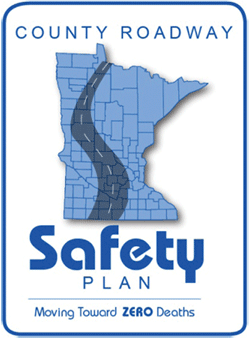Data Analysis for County Highway Safety Plans
Original publication: HSIP Noteworthy Practice Series, Safety Data Collection, Analysis, and Sharing; FHWA-SA-11-02; 2011(PDF, 1.6MB)
The Minnesota Department of Transportation (MnDOT) has made $3.5 million available to develop Highway Safety Plans for each of the State’s 87 counties. The concept is to build on the foundation established by Minnesota’s Strategic Highway Safety Plan (SHSP), with the primary objective of identifying a specific set of safety projects directly linked to the causation factors associated with the most severe crashes on each county’s highway system.
The first step in developing each county plan has been to conduct a comprehensive crash analysis to disaggregate crashes by system (state or local), severity (serious injury, fatal), location type (urban or rural), and crash type. Through comprehensive crash analysis, MnDOT assisted counties with identifying whether the majority of the severe crashes are occurring on the state or local system and in urban or rural areas. This helps identify where the greatest proportion of crashes are occurring, as well as the primary crash types.

The counties have then disaggregated the crashes based on the 22 emphasis areas identified by the American Association of State Highway and Transportation Official’s (AASHTO) to identify the critical emphasis areas (e.g., young drivers, seat belt usage, road departure, intersections). The identified emphasis areas represent the greatest potential to significantly reduce the number of severe and fatal crashes in the corresponding county.
Once emphasis areas were identified, an initial list of potential safety countermeasures was compiled using the strategies included in the National Cooperative Highway Research Program (NCHRP) 500 Series Reports – Guidance for Implementation of AASHTO’s SHSP. The county staff reviewed the initial list and eliminated strategies considered too expensive or experimental, and the remaining strategies were prioritized through a Safety Strategies Workshop, which included various safety partners in the county (e.g., public works, law enforcement, planning, public health, elected officials, MnDOT staff, etc.). During the workshop the results of the data driven analytical process were shared with the safety partners, who then discussed and prioritized the list of safety strategies.
Following the prioritization of safety strategies, a detailed crash analysis was conducted to identify contributing crash factors and characteristics based on the findings of the initial crash analysis. This analysis identified high risk locations (e.g., segments, horizontal curves, intersection) based on systemwide factors such as number of severe crashes, design features, traffic volumes, curve radius, etc.
In most cases the severe and fatal crashes have been spread over many miles of roadways, resulting in a low density of crashes. To address this issue, one of the key objectives of the county safety plans is to identify low-cost safety-related projects focused on the county’s identified emphasis areas to implement on a systematic basis. At this point in the process, projects were identified based on the results of the detailed crash analysis and the identified high-priority strategies. Some county lists of potential projects have included multiple years of projects – ultimately implementation will be dependent on securing HSIP funding or integration of these low cost measures into other programs such as 3R (Resurfacing, Restoring, Rehabilitation).
Key Accomplishments
- Established a process for developing data-driven county safety plans.
- Provided data analysis support to counties for improved problem and project identification.
- Established a better link between crash causation and implementation of safety strategies on local roadways.
Results
As of December 2010, 23 counties have developed safety plans. The data analysis used to develop the plans has helped position counties to more effectively identify projects eligible for future HSIP funding cycles and to make improvements on local roadways with greater potential to reduce the number of fatal and serious injury crashes. The comprehensive data analysis has also positioned MnDOT to more subjectively quantify safety needs on the local roadways as part of the State’s systemic approach to safety improvements. Furthermore, through a process similar to the development of the statewide SHSP, development of county safety plans have fostered a greater safety culture among county stakeholders.
Contact
Brad Estochen
Minnesota Department of Transportation
651-234-7011
bradley.estochen@dot.state.mn.us
